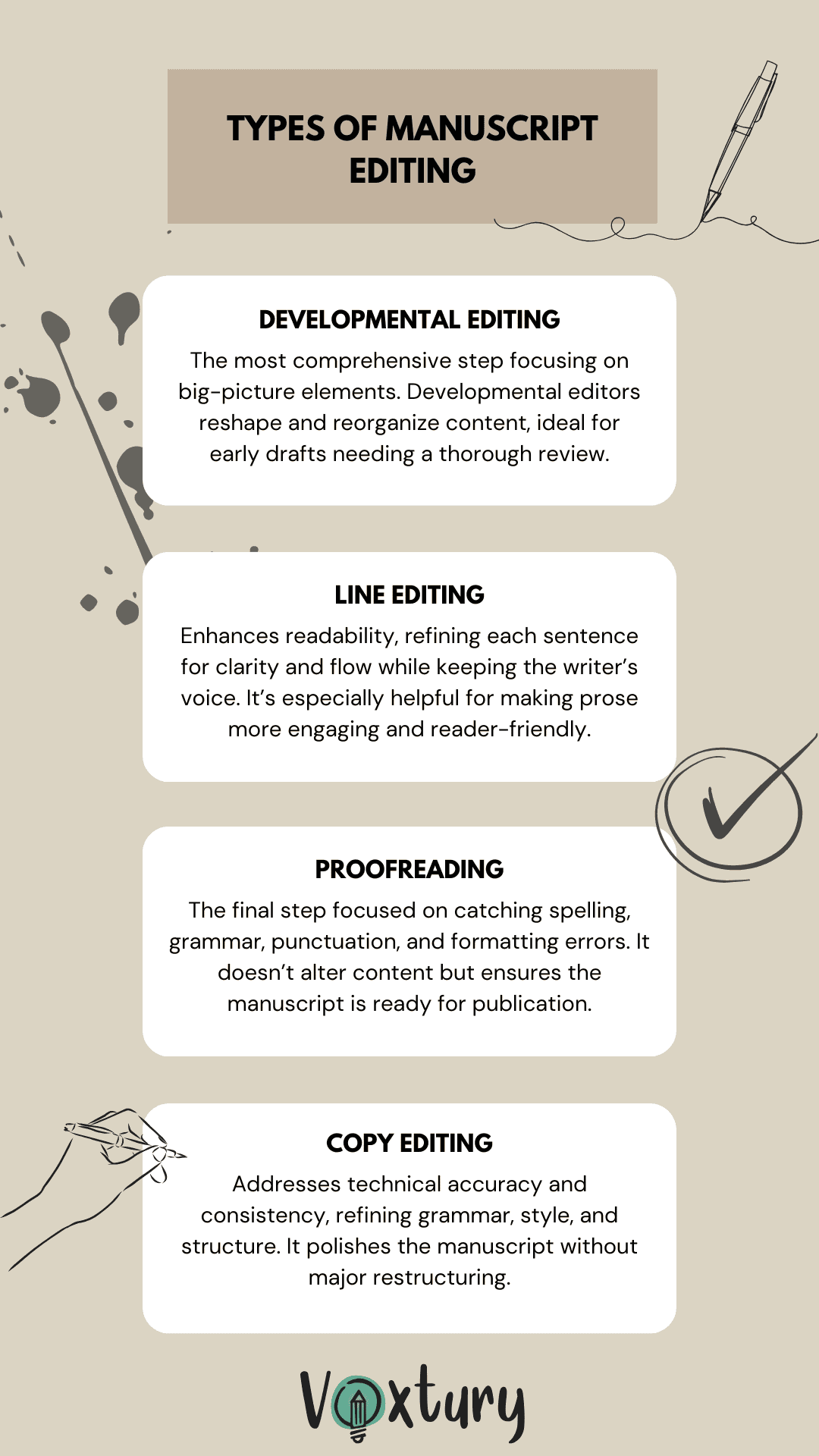Writing a manuscript is no small feat. Whether you’re crafting a novel, an academic paper, or a professional document, transforming ideas into a well-structured narrative requires significant effort. But once the words are on the page, a crucial step remains: manuscript editing. This process is essential for refining your work, enhancing clarity, and ensuring that your message resonates with readers.
Manuscript editing is more than just correcting typos or grammatical errors; it’s an in-depth evaluation that elevates the quality of your writing by focusing on flow, structure, and coherence. A skilled manuscript editor doesn’t just polish the text—they bring out its full potential, shaping it into something compelling and professional. In this article, we’ll explore what manuscript editing involves, the various types available, and how it can transform your work from good to great.
Key Takeaways
- Manuscript editing is essential for improving clarity, readability, and professionalism in your writing.
- Different types of editing—proofreading, copy editing, line editing, and developmental editing—each focus on unique aspects of refining a manuscript.
- A professional manuscript editor brings valuable insights, enhancing the flow, style, and structure of your work.
- Self-editing tools can be a helpful first step, allowing writers to address basic issues before seeking professional help.
- Combining self-editing with professional editing provides a polished, high-quality manuscript that’s ready for readers or publication.
What Is Manuscript Editing?

At its core, manuscript editing is the process of refining a draft to improve its clarity, readability, and overall impact. Unlike simple proofreading, which focuses primarily on correcting spelling and grammar, manuscript editing delves into the structure, style, and flow of the content. This means addressing not just surface-level errors but also ensuring that ideas are presented logically, sentences are clear, and the tone aligns with the intended audience.
Manuscript editing generally involves several stages, each with a unique focus. We’ll provide a more detailed explanation later on but for now, here are some bite-sized pieces of information for you:
- Developmental Editing: This is the most comprehensive stage, often involving substantial revisions. Here, editors may suggest reworking sections, adding or removing content, and restructuring the manuscript to enhance its overall flow and coherence. It’s an ideal starting point for authors seeking a high-level critique.
- Line Editing: Line editing focuses on the craft of writing, including sentence structure, word choice, and tone. It’s about refining each line to ensure clarity and precision without losing the author’s voice. Line editing can significantly enhance readability and make the text more engaging.
- Copy Editing: Copy editing zeroes in on technical aspects, such as grammar, punctuation, and consistency. This stage polishes the language, ensuring it’s error-free and adheres to any relevant style guides, making it ready for publication or submission.
- Proofreading: It is the final check before publishing, where minor errors like typos, grammar mistakes, and formatting issues are fixed. It doesn’t change the content itself but ensures everything looks polished and professional, giving readers a smooth, error-free experience.
Editor’s Note
Each stage of manuscript editing serves a specific purpose, and the approach may vary depending on the manuscript’s needs. A skilled manuscript editor is trained to assess the level of editing required, helping authors enhance their work from various angles. Understanding these distinctions allows authors to choose the editing services best suited to their project’s stage and goals.
Related Article: Guide to Writing a Manuscript
Types of Manuscript Editing
Manuscript editing involves several distinct types of editing, each designed to address different aspects of a manuscript’s quality. From final checks to in-depth revisions, understanding the different types of editing helps authors select the right approach for their work.
Here’s a detailed breakdown of each type:
Proofreading
Proofreading is the final step in the editing process, aimed at catching surface-level errors that may have been missed during earlier editing stages. Proofreaders focus on correcting spelling, grammar, punctuation, and formatting inconsistencies.
Unlike more intensive forms of editing, proofreading does not involve revising sentence structure or content; instead, it polishes the text, ensuring it’s error-free and ready for publication. If you’re at the stage where your manuscript is nearly complete, proofreading can provide that last layer of refinement before releasing it to readers.
Copy Editing
Copy editing goes a step beyond proofreading by addressing both technical accuracy and consistency. Copy editors review the manuscript with an eye for grammatical accuracy, sentence structure, and style, making sure the writing aligns with a specific style guide if applicable. They focus on maintaining consistent terminology, tone, and formatting, and they may also suggest minor revisions to improve clarity.
This stage is ideal for manuscripts that require polishing but do not need significant restructuring. A solid copy edit ensures that the language is precise, clear, and free from distracting errors, setting the foundation for a professional presentation.
Related article: Essential story writing tips

Line Editing
Line editing is a more detailed process that examines each sentence for clarity, impact, and flow. A line editor pays close attention to the writer’s style and voice, refining sentences to enhance readability while retaining the original tone. They may rework sentence structure, adjust word choice, and smooth out awkward phrasing to improve the manuscript’s overall readability.
Line editing is especially helpful for authors looking to make their prose more engaging and polished. It provides a layer of refinement that enhances the reader’s experience, making it easier for them to connect with the content on a deeper level.
Developmental Editing
Developmental editing is the most comprehensive and in-depth form of manuscript editing. It focuses on the “big picture,” including story structure, character development, plot, and thematic elements for fiction, or organization and argumentation for nonfiction.
Developmental editors work with authors to reshape the manuscript, which may involve rearranging sections, expanding on certain ideas, or even removing parts that don’t serve the overall purpose.
This type of editing is ideal for authors in the early stages of a project or those seeking a high-level critique. Developmental editing provides invaluable insights that can transform a draft into a cohesive, compelling manuscript ready for line or copy editing.
Why Is Manuscript Editing Important?
Manuscript editing is more than just an optional step—it’s essential for creating a polished, professional piece of writing. It can make the difference between a rough draft and a refined, impactful document. Here are some of the key reasons why manuscript editing is so important:
Clarity and Coherence
Manuscript editing helps organize your ideas, making them easier for readers to follow. Editors ensure that thoughts flow logically from one point to the next, enhancing clarity and making the text accessible to your target audience.
Consistency and Quality
Manuscript editors look out for inconsistencies in tone, style, and formatting. Whether it’s character names, dates, or stylistic choices, maintaining consistency throughout a manuscript strengthens the reading experience and keeps the focus on the content rather than on errors or distractions.
Enhancing Readability
A well-edited manuscript is not only grammatically correct but also engaging and enjoyable to read. Editors refine sentence structure and word choice, ensuring that the language flows smoothly and holds the reader’s attention.
Improving Professionalism
For manuscripts intended for publication, professionalism is key. Even a few errors or awkward phrases can detract from the credibility of your work. An experienced manuscript editor ensures that your writing meets high standards, helping you make a positive impression on readers, publishers, or reviewers.
Keep In Mind
Investing in manuscript editing means investing in the quality and impact of your writing. An editor’s insight and skill can uncover hidden potential in your manuscript, helping you communicate your message effectively and professionally. Ultimately, manuscript editing enhances the reader’s experience, allowing your ideas to shine without distraction.
Related article: Ultimate copywriting tips for beginners
The Role of a Manuscript Editor

A manuscript editor is like a trusted guide for your writing—they look over your work with a keen eye, catching areas where clarity, flow, or structure could use a boost. They go beyond fixing basic mistakes; they fine-tune your manuscript so it reads smoothly, feels cohesive, and genuinely connects with your audience. Their goal is to bring out the best in your writing, making sure your ideas are as clear and impactful as possible.
But here’s the good news: you don’t have to rely solely on a professional editor if you prefer to handle some editing yourself. Today, there are plenty of online text editing tools—like the ones offered by Voxtury—that make it easy to catch duplicate words, tweak your style, and improve readability. These tools offer real-time feedback and corrections, helping you polish your draft before even handing it over to an editor.
Related article: How to edit a book
Make Your Writing Shine with Manuscript Editing
Manuscript editing is the secret ingredient that turns a draft into something polished and ready to impress. Whether you’re writing a short story or a research paper, each stage of editing—from proofreading to developmental edits—helps your work flow better, sound clearer, and feel more engaging.
By investing in manuscript editing, you’re giving your work the best chance to shine. With the right combination of self-editing tools and professional help, your ideas come through loud and clear, and your unique voice truly connects with readers. So whether you tackle it yourself, team up with a pro, or mix both approaches, manuscript editing is a step you won’t want to skip in creating something you’re proud to share.
Explore Voxtury’s online text editing tools to enhance your writing.
SOURCES
At Voxtury, we prioritize using high-quality sources, including peer-reviewed studies, to ensure our articles are accurate, reliable, and trustworthy. To learn more about our commitment to quality and how we fact-check our content, please visit our editorial process page.
- Kole, M. (n.d.) – Types of Manuscript Editing
- True Editors – What is Manuscript Editing and Why is it Important